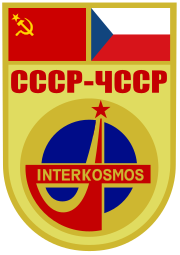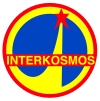Soyuz 28
| COSPAR ID | 1978-023A |
|---|---|
| SATCAT no. | 10694 |
| Mission duration | 7 days, 22 hours, 16 minutes |
| Spacecraft properties | |
| Spacecraft type | NPO Energia |
| Launch mass | 6,800 kilograms (15,000 lb) |
| Crew | |
| Crew size | 2 |
| Members | Aleksei Gubarev Vladimír Remek |
| Callsign | Зенит (Zenit – "Zenith") |
| Start of mission | |
| Launch date | 2 March 1978, 15:28 UTC |
| Rocket | 1/5[1] |
| End of mission | |
| Landing date | 10 March 1978, 13:44 UTC |
| Landing site | 51°N 67°E / 51°N 67°E |
| Orbital parameters | |
| Reference system | Geocentric |
| Regime | Low Earth |
| Perigee altitude | 198.9 kilometres (123.6 mi) |
| Apogee altitude | 275.6 kilometres (171.2 mi) |
| Inclination | 51.65 degrees |
| Period | 88.95 minutes |
| Docking with Salyut 6 | |

Soyuz programme (Crewed missions) | |
Soyuz 28 (Russian: Союз 28, Union 28) was a March 1978 Soviet crewed mission to the orbiting Salyut 6 space station.[2] It was the fourth mission to the station, the third successful docking, and the second visit to the resident crew launched in Soyuz 26.
Crew
| Position | Cosmonaut | |
|---|---|---|
| Commander | EP-2 Second and last spaceflight | |
| Research Cosmonaut | EP-2 Only spaceflight | |
Backup crew
| Position | Cosmonaut | |
|---|---|---|
| Commander | Nikolai Rukavishnikov | |
| Research Cosmonaut | Oldřich Pelčák, IK | |
Mission parameters
- Mass: 6,800 kg (15,000 lb)
- Perigee: 198.9 km (123.6 mi)
- Apogee: 275.6 km (171.2 mi)
- Inclination: 51.65°
- Period: 88.95 minutes
Mission highlights
The Soyuz 28 mission was the first Intercosmos flight, whereby military pilots from Soviet bloc nations were flown on flights of about eight days to a Soviet space station. Pilots from other nations would eventually also fly. The program was a reaction to American plans to fly Western Europeans on Space Shuttle missions.[3]: 182
Vladimir Remek, the first non-Soviet, non-American to travel to space, was launched aboard Soyuz 28 on 2 March 1978, after a three-day delay of unspecified cause. The Soyuz commander was Soviet cosmonaut Aleksei Gubarev. The crew docked with the orbiting Salyut 6 space station, and greeted the occupants
The day after the docking, the Soyuz 26 crew celebrated their breaking of the space endurance record of 84 days, set by the Skylab 4 crew in 1974.[4]: 109
While the mission had a political purpose, scientific experiments were carried out, including one which monitored the growth of
On 10 March, the Soyuz 28 crew prepared for their return to Earth, packing experiments and testing systems. They undocked from the station and landed 310 kilometres (190 mi) west of
A joke appeared soon after the mission that Remek's hand had mysteriously turned red. He informed the doctors, the joke goes, that this was because every time he went to touch something, the Soviet crewmembers would slap his hand and yell, "Don't touch that!"[5]
References
- ^ "Baikonur LC1". Encyclopedia Astronautica. Archived from the original on 2009-04-15. Retrieved 2009-03-04.
- ^ The mission report is available here: http://www.spacefacts.de/mission/english/soyuz-28.htm
- ^ ISBN 978-0-87201-848-8.
- ^ ISBN 978-0-517-56954-2.
- ISBN 978-0-16-088358-3. Retrieved 5 August 2012.


